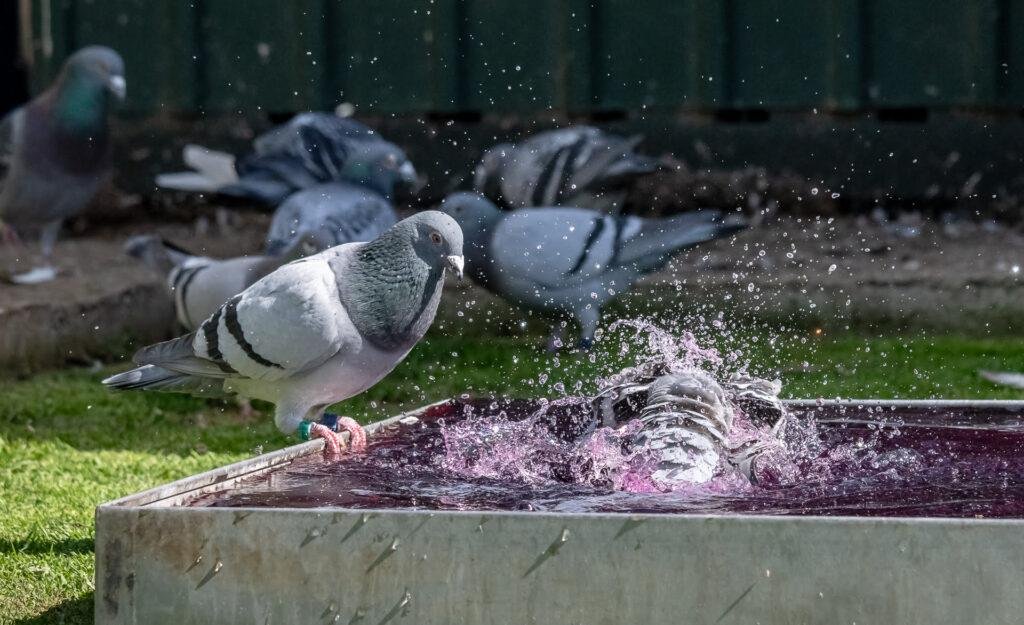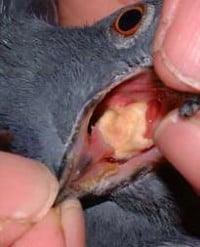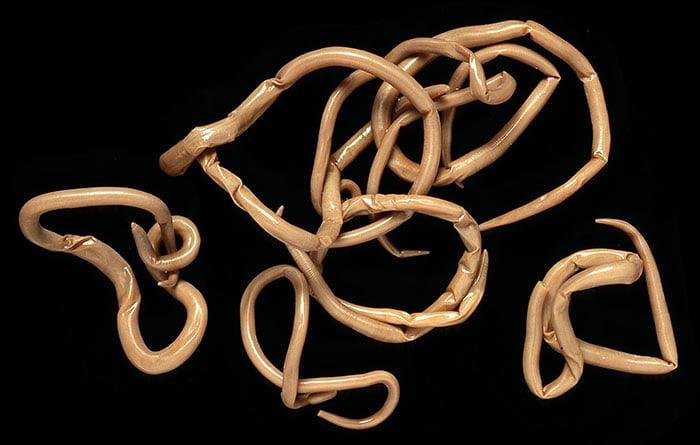Racing pigeon Diseases
racing pigeon diseases
I have valuable expertise regarding pigeon diseases and treatments. with hands-on experience over 35 years in the sport i have seen it all if you get the loft right and keep them clean you will keep lots of pigeon diseases at bay, over time you will learn so much and at time you will be telling the vet what you need also get a second opinion from a fellow pigeon flyer if you are in doubt, below are the main diseases and treatments

BELOW ARE THE MOST COMMON RACING PIGEON DISEASES

CANKER
Canker, also known as Trichomoniasis, is a parasitic infection that is very common in racing pigeons, affecting up to 80% of pigeons worldwide. It’s caused by a microscopic organism called a trichomonad.
Here’s what to look for in your racing pigeons:
- Oral lesions:
- YOUTUBE LINK Check their mouth for white or yellowish spots,can look like a cheesy growth inside the mouth especially around the soft palate. These can develop into larger, crusty masses.
- Difficulty eating: Birds with canker may have trouble swallowing due to mouth soreness, and they might exhibit repeated swallowing motions.
- Listlessness and weight loss: Sick birds will be less active and lose weight due to reduced appetite.
- Respiratory issues: In severe cases, canker can affect the respiratory tract, causing difficulty breathing.
- Other signs: Look for ruffled feathers, increased water intake, drooling, and diarrhea.
If you suspect canker in one of your pigeons, it’s important to isolate the bird and seek veterinary help. Early diagnosis and treatment are crucial for a full recovery. Here’s what the vet might recommend:
- Medication: Medications like ronidazole are commonly used to treat canker.
- Supportive care: The vet might prescribe electrolytes or other supportive medications to help the bird recover.
Prevention is key to avoiding canker outbreaks. Here are some tips:
- Routine treatment: Many fanciers treat their pigeons for canker before breeding season and periodically throughout the year.
- Hygiene: Maintain a clean loft environment and disinfect feeders and waterers regularly.
- Stress management: Reduce stress factors in your loft, such as overcrowding or poor ventilation.
- Nutrition: Provide your pigeons with a balanced diet to keep their immune system strong.
By being vigilant and taking preventive measures, you can help keep your racing pigeons healthy and canker-free.
below is the best canker treatments about some of these will do canker,cocci,worms,fleas these are called 4 in 1 or a 3 in 1

COCCIDIOSIS
Coccidiosis is a common parasitic disease in racing pigeons YOUTUBE LINK caused by protozoan organisms of the genus Eimeria. It primarily affects the digestive system. Here’s what you need to know:
Symptoms:
- Watery or mucoid diarrhea, sometimes with blood YOUTUBE LINK
- Weight loss and poor body condition
- Lethargy and weakness
- Ruffled feathers
- Decreased appetite
- Poor racing performance
- pigeons can drink lots of water
To determine if your pigeons have coccidiosis:
- Observe for symptoms: Watch for the signs listed above.
- Fecal examination: A veterinarian can perform a microscopic examination of droppings to look for oocysts (eggs) of the parasite.
- Post-mortem examination: In severe cases, a necropsy may reveal intestinal damage.
- Laboratory tests: PCR tests can detect and identify specific Eimeria species.
If you suspect coccidiosis, it’s best to consult with a veterinarian experienced in avian medicine. or a good pigeon flyer They can provide a definitive diagnosis and recommend appropriate treatment.
below is the best cocci treatments about some will be 4 in 1

WORMS
When it comes to racing pigeons and potential parasite issues like worms and hairworms, here are some key things to look out for: YOUTUBE LINK
- Weight loss despite normal eating habits
- YOUTUBE LINK
- Diarrhea or loose droppings
- Visible worms in droppings
- Lethargy or reduced performance
- Poor feather quality
- Hairworms (Capillaria):
- Ruffled feathers, especially around the neck
- Emaciation
- Diarrhea with mucus
- Reduced appetite
- Weakness
To confirm the presence of worms or hairworms, it’s best to have a veterinarian perform a fecal examination.OR JUST ASK A LOCAL FLYER Regular deworming and good loft hygiene are crucial for prevention.
below is the best treaments for worms some of these wil be a all in one treaments

PARAMYXOVIRUS
PMV or paramyxovirus both are the same in racing pigeons refers to Paramyxovirus, a serious viral disease that affects pigeons.
The pigeons’ heads tremble, they twist their necks in a funny way, sometimes so much that the top of their heads points to the ground. Their movements are disordered, they often spin around, stagger and lurch about, and do backwards cartwheels. Those with such severe symptoms cannot possibly consume their feed, but consumption of water and food can be a problem even for those with milder symptoms.
ALL PIGEONS HAVE TO BE VACCINATED BEST TO THIS WHEN A FEW WEEKS OLD
How PMV affects pigeons:
- Respiratory system: The virus can cause inflammation in the respiratory tract.
- Nervous system: It often affects the brain and nervous system, leading to neurological symptoms.
- Digestive system: Can cause inflammation in the intestines, leading to diarrhea.
- Immune system: Weakens the bird’s overall immunity, making it susceptible to secondary infections.
Symptoms:
- Neurological signs: CLIICK LINK BELOW
- Head twisting or tilting
- Circling or walking backwards
- Wing and leg paralysis
- Tremors and uncoordinated movements
- Respiratory signs:
- Sneezing and coughing
- Difficulty breathing
- Digestive signs:
- Watery, green diarrhea
- Loss of appetite
- Weight loss
- Other signs:
- Excessive thirst and urination
- Swollen eyes or head
- Drooping wings
- Lethargy and depression
Prevention methods:
- Vaccination:
- Regular vaccination is crucial
- Usually given annually, but may be more frequent in high-risk areas
- Quarantine:
- Isolate new birds for at least 30 days before introducing them to the flock
- Separate sick birds immediately
- Hygiene:
- Regular cleaning and disinfection of lofts, feeders, and drinkers
- Proper disposal of droppings and contaminated materials
- Biosecurity:
- Limit visitor access to lofts
- Use separate clothing and footwear when handling different groups of birds
- Stress reduction:
- Avoid overcrowding
- Provide a balanced diet and clean water
- Minimize unnecessary handling or transportation
- Monitoring:
- Regular health checks
- Quick response to any signs of illness

BACTERIAL INFECTIONS
Causes of Bacterial Infections in Racing Pigeons
There are a number of factors that can contribute to bacterial infections in racing pigeons, including:
- Stress: Stress from racing, overcrowding, or poor loft conditions can weaken a pigeon’s immune system YOUTUBE and make them more susceptible to infection.
- Poor hygiene: A dirty loft with contaminated food and water can harbor bacteria and increase the risk of infection.
- Introduction of new birds: Introducing new birds to a loft can introduce new pathogens that can sicken other pigeons.
- Nutritional deficiencies: Pigeons that are not getting the nutrients they need are more likely to develop infections.
- Paratyphoid: This is a serious infection caused by Salmonella bacteria. It can cause weight loss, diarrhea, and lethargy in pigeons.
- Colibacillosis: This is an infection caused by E. coli bacteria. It can cause respiratory problems, diarrhea, and septicemia (blood poisoning) in pigeons.
- Chlamydiosis: This is an infection caused by Chlamydia bacteria. It can cause respiratory problems, conjunctivitis (inflammation of the eyes), and weight loss in pigeons.
- Mycoplasmosis: This is a chronic respiratory infection caused by Mycoplasma bacteria. It can cause coughing, sneezing, and difficulty breathing in pigeons
Preventing Bacterial Infections
There are a number of things that racing pigeon fanciers can do to help prevent bacterial CLICK HERE infections in their birds, including:
- Maintaining a clean and sanitary loft
- Providing pigeons with a balanced diet
- Reducing stress on pigeons
- Avoiding overcrowding in the loft
- Quarantining new birds before introducing them to the loft
- Vaccinating pigeons against common bacterial infections
- Regularly monitoring pigeons for signs of illness
Treatment of Bacterial Infections
If a racing pigeon is suspected of having a bacterial infection, it is important to seek veterinary treatment immediately. The veterinarian will likely prescribe antibiotics to treat the infection. In some cases, other medications may also be needed.
Here are some additional tips for keeping your racing pigeons healthy:
- Have your pigeons checked by a veterinarian regularly.
- Keep a log of your pigeons’ health, including their weight, appetite, and droppings.
- Be aware of the signs of illness in pigeons, such as weight loss, diarrhea, respiratory problems, and lethargy.
- If you notice any signs of illness in your pigeons, isolate them from other birds and contact a veterinarian immediately.
By following these tips, you can help to keep your racing pigeons healthy
THE BELOW ARE THE VERY BEST ABOUT NUMBER 2 IS VERY GOOD

PRODUCTS YOU NEED
Lice are a common problem for racing pigeons, Here’s some information about lice in racing pigeons:
YOUTUBE CLICK HERE
- Signs and Symptoms: The most common signs of lice infestation in pigeons are restlessness, itching, and pecking at their feathers. You may also see lice or their eggs (nits) on the bird’s body, especially around the vent, breast, and wings.
- Effects: Lice can cause a number of problems for pigeons, including anemia, weight loss, and secondary skin infections. A heavy lice infestation can also stress the birds and make them more susceptible to other diseases.
- LOFT DISINFECTION
You should disinfect your loft primarily to address two main issues: pest infestations and the health risks they carry. Disinfection eliminates pathogens left behind by pests and creates a less hospitable environment for them to return.
Here’s a breakdown of the reasons to disinfect your loft:
- Eliminate Disease-Causing Pathogens: Pests like rodents, birds, and even some insects can leave behind droppings, nesting materials, and even carcasses. These can harbor harmful bacteria and viruses that can cause illnesses like Hantavirus, Leptospirosis, and Psittacosis [1]. Disinfection kills these pathogens, making your loft safer.
- Discourage Pests from Returning: Disinfection not only gets rid of existing pathogens but can also leave a residual effect that discourages pests from returning. This is because many disinfectants target the things pests need to survive, such as food sources and favorable living conditions.
Here are some additional reasons to consider disinfecting your loft:
- Allergens: Dust mites and allergens from animal droppings can build up in lofts over time. Disinfection can help reduce these allergens and improve air quality.
- Mold: Damp and poorly ventilated lofts can be susceptible to mold growth. Disinfection can help kill existing mold spores and prevent future growth.
EVERY LOFT WORLDWIDE SHOULD HAVE THE BELOW USE ONCE A WEEK AND A DEEP CLEAN EVERY MONTH
THE 2 BELOW ARE THE NUMBER 1
